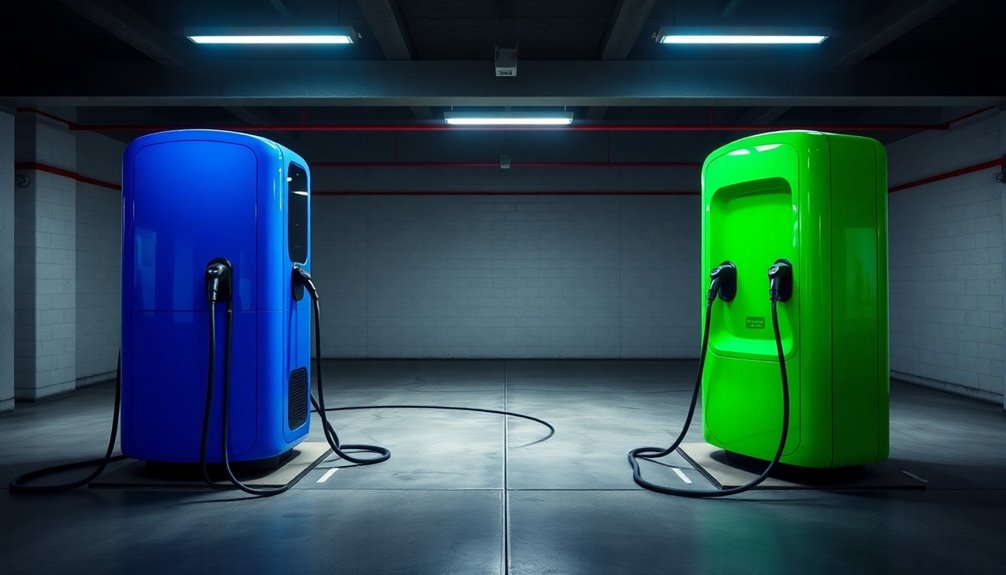When it comes to CCS versus CHAdeMO, knowing the differences can save you from being left powerless. CCS uses a single port for both AC and DC charging, making it more convenient and faster, with charging times around 24 minutes for a significant boost. CHAdeMO, while popular in Japan, uses separate ports and usually charges slower. Geographic availability matters, too; CCS dominates in North America and Europe, while CHAdeMO is prevalent in Asia. Understanding these details ensures you choose wisely for your electric vehicle. Keep exploring the nuances to see how this battle affects your charging decisions moving forward.
Key Takeaways
- CCS offers faster charging speeds of up to 350 kW, while CHAdeMO typically maxes out at 125 kW, affecting charging efficiency.
- CCS combines AC and DC charging in one port, enhancing convenience, whereas CHAdeMO requires separate ports, complicating the charging process.
- Geographic adoption varies, with CCS dominating North America and Europe, while CHAdeMO remains prevalent in Japan and parts of Asia.
- Major automakers are increasingly adopting CCS for newer EV models, indicating a shift in market preferences towards this standard.
- CHAdeMO's bi-directional charging allows energy discharge back into the grid, adding value for energy management compared to CCS.
Connector Design Comparison
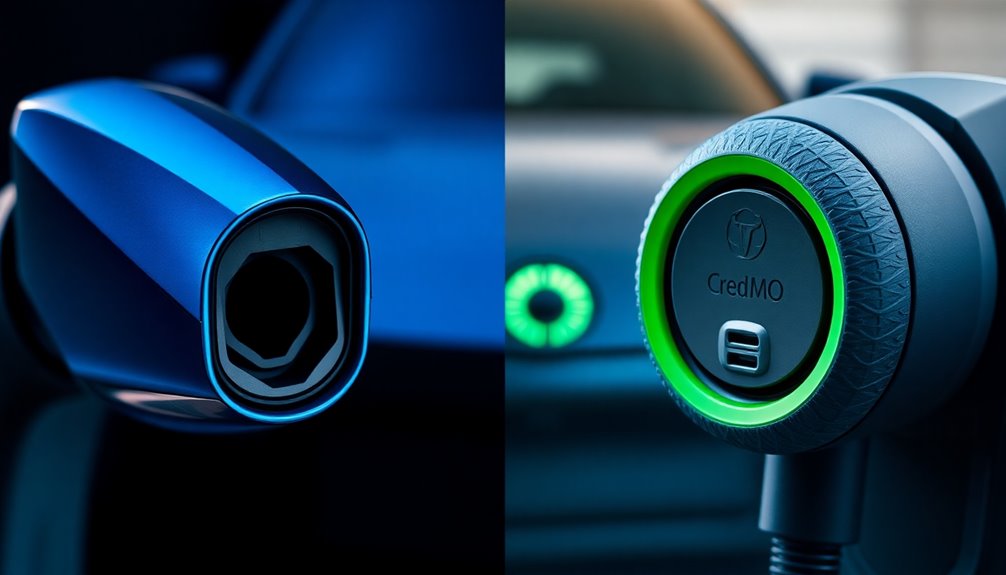
When it comes to connector design, the battle between CCS and CHAdeMO showcases distinct philosophies that cater to different needs. CCS utilizes a single port for both AC and DC charging, streamlining the charging process for you. In contrast, CHAdeMO requires two separate ports, one for AC and another for DC, which can be less convenient.
The connector types also differ significantly. CCS combines the SAE J1772 Type 1 or Type 2 plug with added DC fast-charging pins, while CHAdeMO boasts a unique design that's not compatible with these standard plugs. This difference in design leads to varying levels of hardware complexity; CCS's dual capacity necessitates more intricate hardware, which can drive up costs. On the other hand, CHAdeMO's simpler design results in lower upfront costs.
Regionally, CCS enjoys widespread adoption in North America and Europe, backed by a broad range of manufacturers, including Tesla and BMW. CHAdeMO, however, is primarily supported by Japanese automakers like Nissan. As the market evolves, many manufacturers are transitioning from CHAdeMO to CCS for better global compatibility, reflecting a shift in connector design preferences. Additionally, various EV charging connectors exist with unique features that influence the choice between CCS and CHAdeMO.
Charging Speed Overview
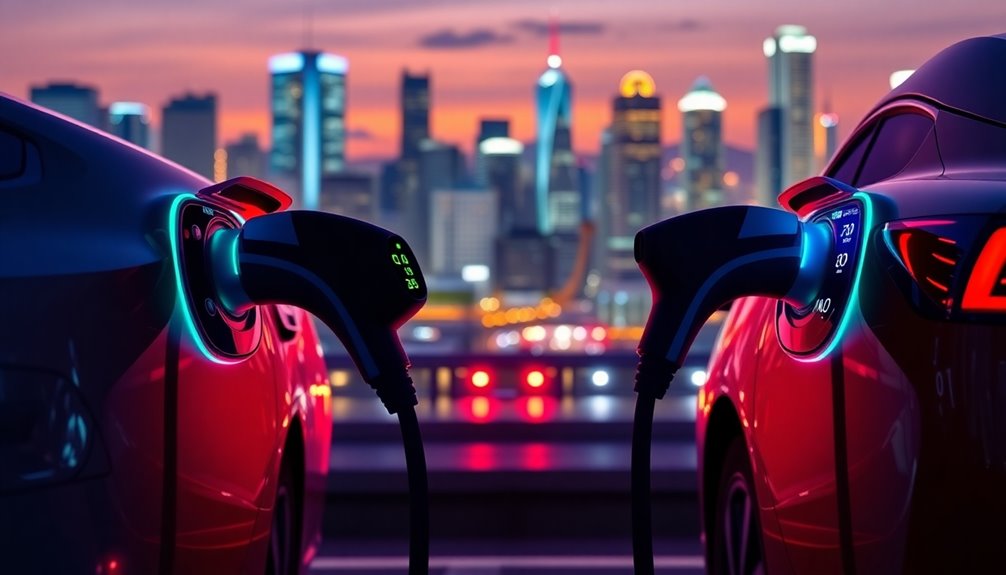
Charging speed is a critical factor for electric vehicle (EV) owners, influencing convenience and overall driving experience. When you compare CCS and CHAdeMO, CCS clearly stands out. It can deliver up to 350 kW of power, allowing for significantly faster charging times. In fact, CCS can charge your EV up to three times faster than CHAdeMO, which typically maxes out at around 125 kW.
If you're in a hurry, CCS chargers can take your vehicle from 10 to 90% in just 24 minutes, as demonstrated by the Genesis GV70 Electrified. In contrast, CHAdeMO chargers may take 30 to 60 minutes to reach about 80%. While CHAdeMO is compatible with popular brands like Nissan and Toyota, it simply can't match the charging capabilities of CCS.
However, the actual charging speed you experience will depend on your vehicle's battery capacity and the charger's efficiency. Some EVs might not fully utilize the maximum power output of CCS chargers, but overall, CCS offers a more versatile and quicker charging experience. Furthermore, ongoing improvements in charging infrastructure will continue to enhance the overall CCS experience. When charging speed matters, CCS is the clear winner in this battle.
Geographic Adoption Trends
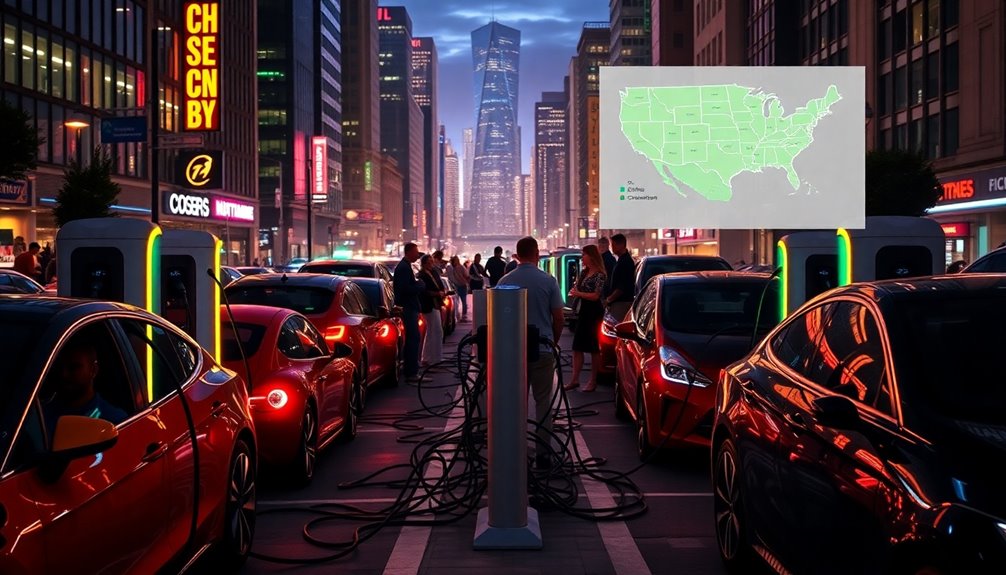
Geographic adoption trends reveal a stark divide between CCS and CHAdeMO, shaping the landscape of electric vehicle charging infrastructure. CHAdeMO has firmly established its presence in Japan and parts of Asia, boasting over 40,000 charging outlets as of 2020. Supported by major Japanese automakers like Nissan and Toyota, it thrives in these markets but struggles to gain traction in North America and Europe.
On the flip side, CCS is rapidly becoming the go-to standard in North America and Europe. With backing from companies like BMW and Volkswagen, CCS infrastructure has surged since 2014, particularly in regions where major automakers are located. In fact, Europe now shows a significant preference for CCS over CHAdeMO, while North America's adoption is driven by government initiatives and a growing EV market. This widespread adoption is further bolstered by CCS's ability to support high-power charging capabilities, making it a practical choice for many EV users.
While CHAdeMO remains dominant in Japan, CCS is clearly carving out a larger share in global markets. The future appears bright for CCS, as ongoing investments in EV infrastructure favor its growth, making it an essential standard to consider in your electric vehicle journey.
Infrastructure and Charging Stations
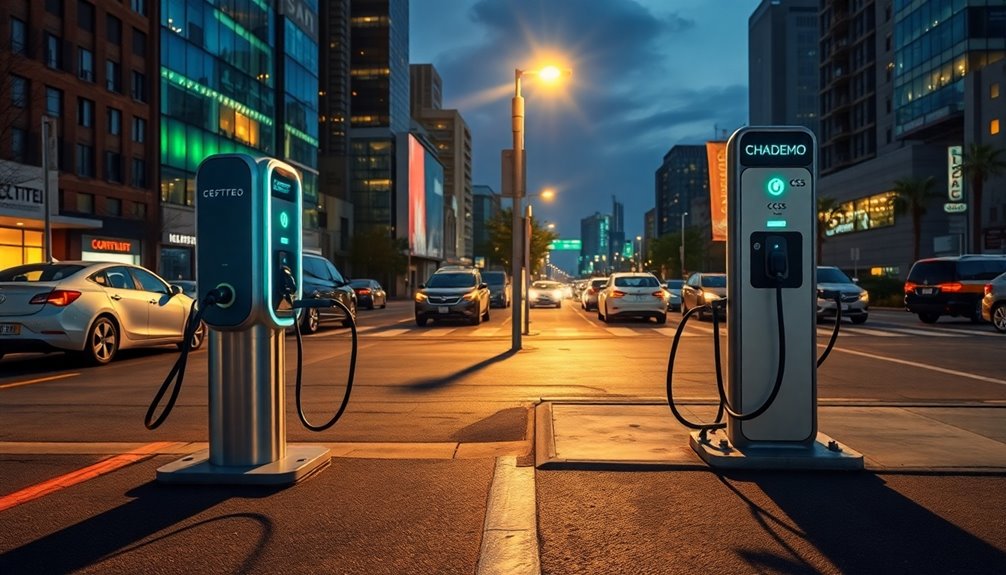
The contrasting geographic adoption trends of CCS and CHAdeMO highlight significant differences in their infrastructure and charging stations. If you're in Japan or parts of Asia, you'll likely find CHAdeMO stations more readily available. However, in Europe and North America, CCS stations dominate the landscape. This disparity affects your charging experience directly.
CHAdeMO requires a separate connector for DC fast charging, limiting its versatility. You'll need two ports on your vehicle if you rely on CHAdeMO, one for AC and another for DC. In contrast, CCS uses a combined connector, allowing your vehicle to charge using a single port for both AC and DC, which is more convenient. Additionally, the charging stations for CCS are increasingly being supported by major automakers, further enhancing its infrastructure.
When it comes to charging speed, CHAdeMO stations typically provide 50 kW or higher, getting you an 80% charge in under an hour. CCS, however, charges much faster, reaching 80% in less than 30 minutes with power outputs ranging from 50 kW to 350 kW. This capability means CCS ensures you can recover range quickly, making it a more efficient option for many EV users.
Vehicle Compatibility Insights
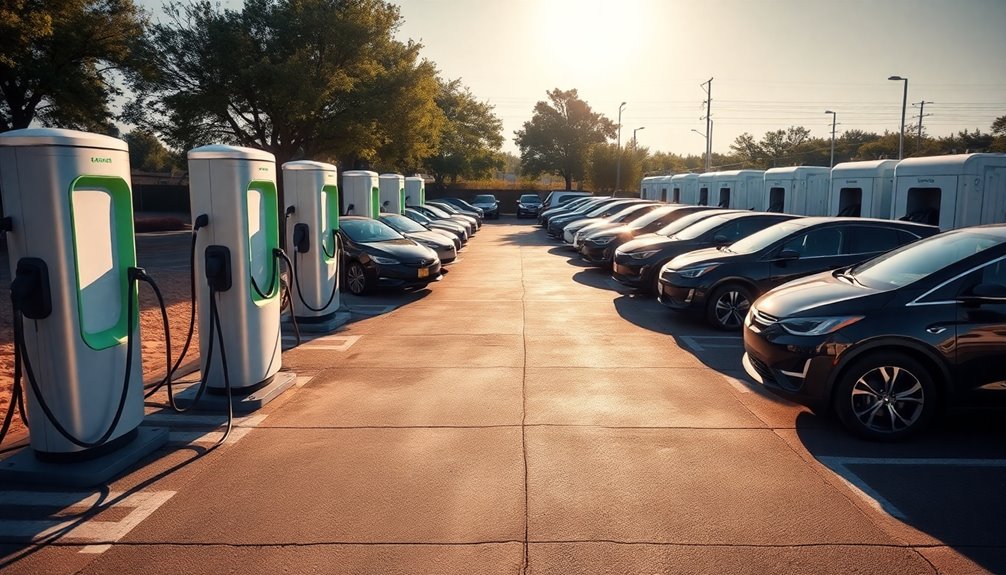
When considering vehicle compatibility, understanding the differences between CCS and CHAdeMO is crucial for EV owners. CHAdeMO is primarily used in Japan and Asia and is commonly found in older model EVs worldwide. If you drive a Nissan Leaf or a Toyota Prius Plug-In, you're likely using CHAdeMO, as it's supported by Japanese automakers like Nissan, Mitsubishi, and Subaru.
On the other hand, CCS has become the dominant standard in North America and Europe. Most European and North American automakers, including Audi, BMW, Volkswagen, Ford, and General Motors, have adopted CCS for their newer models. This means if you own a newer EV from these brands, you're likely compatible with CCS. Recent trends indicate that CCS is expected to dominate the EV market as infrastructure continues to expand.
A key difference lies in the connector design. CHAdeMO requires a separate AC charging port, while CCS combines AC and DC charging into a single plug, allowing for easier access with just one charging port on your vehicle. This can simplify your charging experience significantly, especially if you frequently switch between different charging stations. As you navigate your EV ownership journey, knowing which standard your vehicle supports can save you time and frustration.
Charging Experience Evaluation
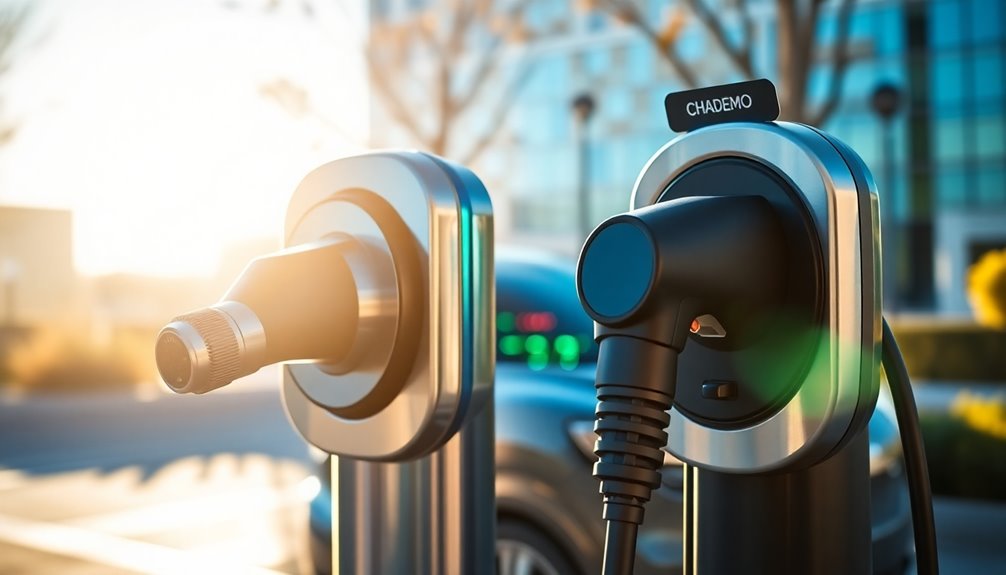
Understanding vehicle compatibility sets the stage for evaluating your charging experience. When it comes to charging speed and efficiency, CCS clearly leads the charge. It can pump out up to 350 kW, allowing you to reach 80% charge in under 30 minutes, while CHAdeMO typically maxes out at 50-100 kW, often taking closer to an hour. Additionally, DC fast charging is essential for long-distance travel convenience, making CCS a more appealing option for those who frequently embark on longer journeys.
Connector design also plays a crucial role. CCS uses a combined connector for both AC and DC charging, which simplifies your experience—one port for all your needs. In contrast, CHAdeMO's unique connector is limited to DC fast charging, making it less versatile.
Charging station availability is another factor. While CHAdeMO is prevalent in Japan and parts of Asia, CCS is gaining traction in Europe and North America, backed by major automakers.
Lastly, consider the cost. CHAdeMO stations are generally cheaper to install and maintain, making it an economical choice for users. However, if you require faster charging, the higher costs associated with CCS may be justified. Ultimately, your charging experience will depend on your specific needs and vehicle compatibility.
Future of Charging Standards
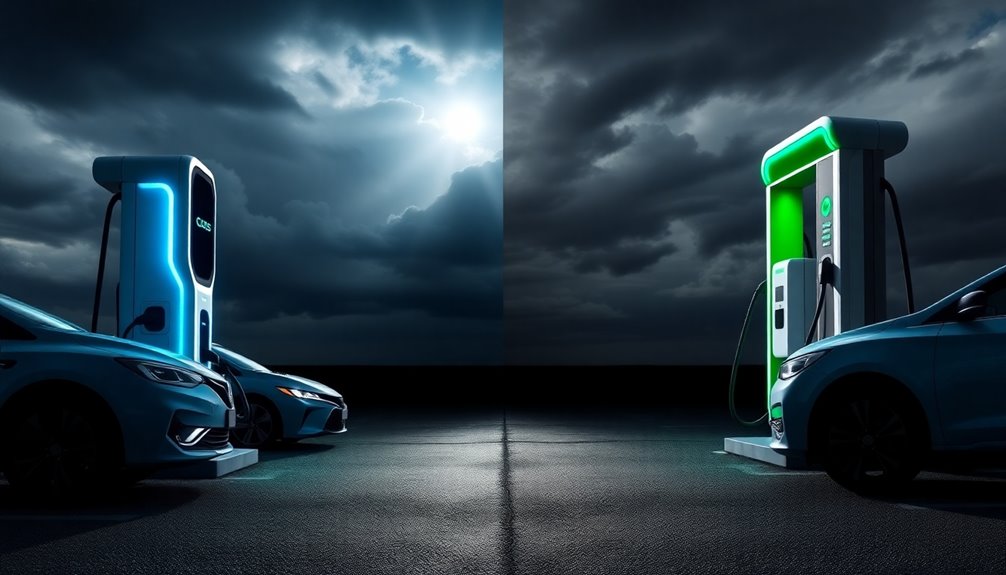
How will the future of charging standards shape the EV landscape? As electric vehicle (EV) adoption continues to surge, the competition between CCS and CHAdeMO will play a crucial role. CCS is gaining traction in Europe and North America, embraced by major brands like Volkswagen and BMW. Its versatility—combining AC and DC charging in one port—offers you greater convenience. On the other hand, CHAdeMO, primarily adopted in Asia, boasts a dedicated DC fast-charging connector, but its slower typical power output might limit your charging experience. Additionally, CHAdeMO's ability to support bi-directional charging enhances its appeal, allowing for energy discharge back into the grid.
Infrastructure development is vital. With over 192,000 public charging ports already available and rapid expansion expected, you'll likely find more CCS stations near you. By 2030, projections estimate 60,000 fast-charging locations, many at existing gas stations, making charging more accessible.
As technology advances, both standards are expected to improve in efficiency and safety, with CCS generally leading in speed. However, CHAdeMO's bi-directional charging adds an interesting dimension to the future. Ultimately, the evolution of these charging standards will significantly shape your EV experience, impacting everything from convenience to charging speed.
Key Takeaways in the Battle
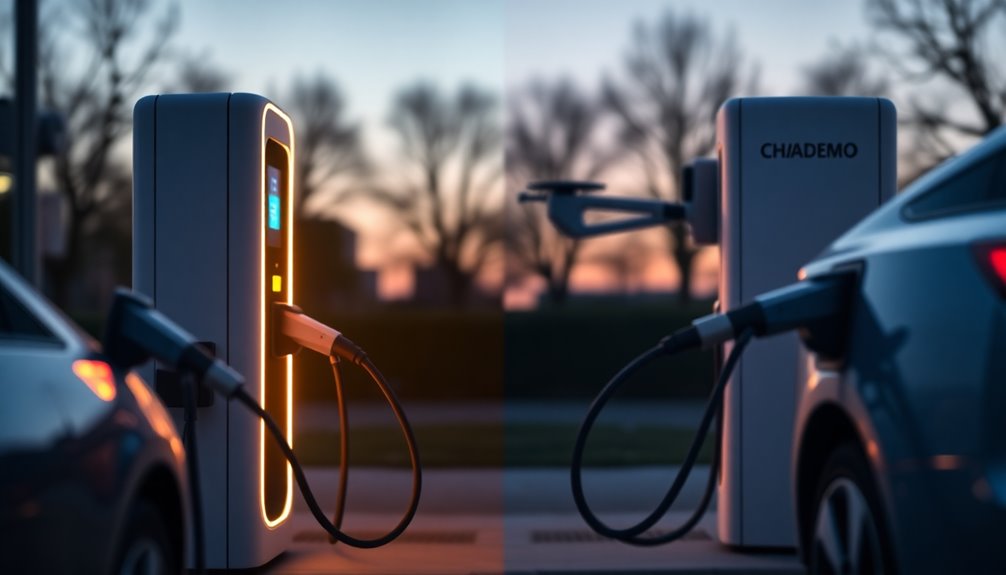
The competition between CCS and CHAdeMO is shaping the future of electric vehicle charging, and several key takeaways highlight the differences between these two standards. First, consider the connector design: CHAdeMO's larger, circular connector requires a separate AC port, while CCS combines AC and DC in one plug, streamlining compatibility.
When it comes to charging speed, CCS takes the lead by delivering power levels between 50 kW and 350 kW, allowing for faster charging times—up to 80% in less than 30 minutes. CHAdeMO can charge to 80% in under an hour but typically supports lower speeds, despite its newer version offering up to 400 kW. The anticipated growth of CCS infrastructure remains limited in the short term, even with higher-power CCS chargers expected to influence market trends eventually.
Regional adoption also plays a crucial role; CHAdeMO is prevalent in Japan, with strong support from Japanese automakers, while CCS dominates in Europe and North America, backed by major brands like Ford and Volkswagen. Finally, charging infrastructure is evolving; although there were more CHAdeMO stations in the U.S. as of 2019, CCS stations are increasingly adopting higher power outputs and broader availability. This landscape suggests that your charging experience may vary significantly based on location and vehicle choice.
Frequently Asked Questions
What Are the Environmental Impacts of CCS and CHADEMO Charging Technologies?
When you consider the environmental impacts of CCS and CHAdeMO charging technologies, it's crucial to look at the electricity sources. If your grid relies on renewables, you'll enjoy a lower carbon footprint while charging. However, if fossil fuels dominate, emissions rise significantly. Additionally, CCS and CHAdeMO each require infrastructure that can affect land use. Ultimately, both technologies can offer benefits, but their environmental impact depends heavily on your local energy mix.
How Do CCS and CHADEMO Handle Charging During Extreme Weather Conditions?
CCS and CHAdeMO chargers both face challenges in extreme weather. In high temperatures, they can experience reduced efficiency and charging speed. You should try to charge during cooler times or in shaded areas to mitigate these effects. While CCS chargers can deliver up to 350 kW, CHAdeMO can reach up to 900 kW under optimal conditions. Keeping your battery above 20% charge during extreme weather can also help maintain performance.
Are There Any Costs Associated With Using CCS or CHADEMO Charging Stations?
Yes, there are costs associated with using CCS and CHAdeMO charging stations. You'll face hardware and installation costs, which can be high due to complex infrastructure needs. Operational costs also vary depending on the kWh rates, often around 48 cents per kWh. If your vehicle isn't compatible, you might need an adapter, adding to your expenses. Regular maintenance is essential too, ensuring the stations work efficiently for your charging needs.
Which Charging Standard Has Better Support for Renewable Energy Integration?
When considering which charging standard better supports renewable energy integration, CCS stands out. It uses the ISO 15118 protocol for smart charging, optimizing energy use from renewables and allowing for seamless Plug & Charge technology. With high-power capabilities up to 350 kW+, it reduces charging time and strain on the grid. While CHAdeMO offers bi-directional charging, CCS's extensive infrastructure and ongoing development make it the more favorable option for integrating renewable energy effectively.
How Do CCS and CHADEMO Impact Battery Health Over Time?
CCS and CHAdeMO both impact battery health over time, primarily through heat generation during fast charging. While both standards use similar battery chemistry, frequent fast charging can degrade your battery if not managed properly. Your EV's Battery Management System helps regulate temperature and current, reducing potential damage. Preconditioning your battery before charging can also minimize heat issues. Following manufacturer guidelines is crucial to preserving your battery's lifespan and ensuring its long-term performance.
Conclusion
In the battle between CCS and CHAdeMO, it's clear that both have their strengths and weaknesses. As you navigate your electric vehicle charging options, consider factors like charging speed, compatibility, and availability in your area. The future of charging standards is evolving, so stay informed and choose what suits your needs best. Ultimately, whether you prefer CCS or CHAdeMO, the key is to ensure you're never left powerless on your journey!
